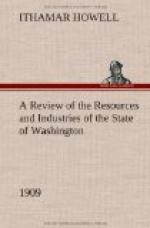A multitude of factories are providing a small part of the merchandise and composes the groundwork of her commerce.
The shores of Elliot bay are lined with wharves accommodating the largest sea-going ships. Its last assessed valuation of property was $203,168,680, and its tax to be raised $975,210.
More than 150 miles of street-car tracks are within her borders and a nickel pays for a 15-mile ride.
Georgetown, in the southern part of Seattle, but not a part of it as yet, has a population of about 5,000, and is an important manufacturing center. Here are the car shops of Seattle Electric Company, gas works, foundries, breweries, machine shops, brick and tile works and many other industries.
Renton, Issaquah, Ravensdale, black Diamond, and new Castle are coal mining towns.
Kent, Auburn, Kirkland, Vashon, north bend, TOLT, fall city, and maple valley are agricultural towns of importance.
KITSAP COUNTY
Kitsap county is nearly surrounded by the waters of Puget sound and Hood’s canal, forming the larger part of the great peninsula which these waters would make an island were a six-mile ridge in Mason county opened up to them. It has extensive and numerous bays and inlets, with magnificent anchorage, and contains in its center the great Port Orchard navy yard, destined to become one of the largest seats in the United States for Uncle Sam’s naval activities.
Resources and industries.
The chief resource of the county is in the lumber. Some of the largest mills of the state are located within its borders.
It is estimated that there are yet 200,000 acres of uncut timber in its borders, and its mills are turning out 600,000 feet of lumber daily, besides vast quantities of shingles.
The fishing industry now includes oyster culture, which is rapidly becoming very important. About the county are located many villages supported by the tillage of the soil from its reclaimed forest lands.
Transportation.
Kitsap county has no railroads, but its waterways are so vast and intricate that all its corners are reached by steamers, and travel is cheap and freight conveniently handled in all parts of the county.
[Illustration: Plate No. 55.—An Okanogan County Valley, Palmer Lake.]
[Illustration: Plate No. 56.—McGowan Seining Grounds, Sand Island, Pacific County.]
[Illustration: Plate No. 57.—Oyster Culture in Willapa Harbor, Pacific County.]
[Illustration: Plate No. 58.—View of the Waterfront at Raymond, Pacific County.]
[Illustration: Plate No. 59.—A View of a Portion of Tacoma’s Harbor, Showing Ships Waiting to Load Lumber and Wheat for Foreign Ports.]




